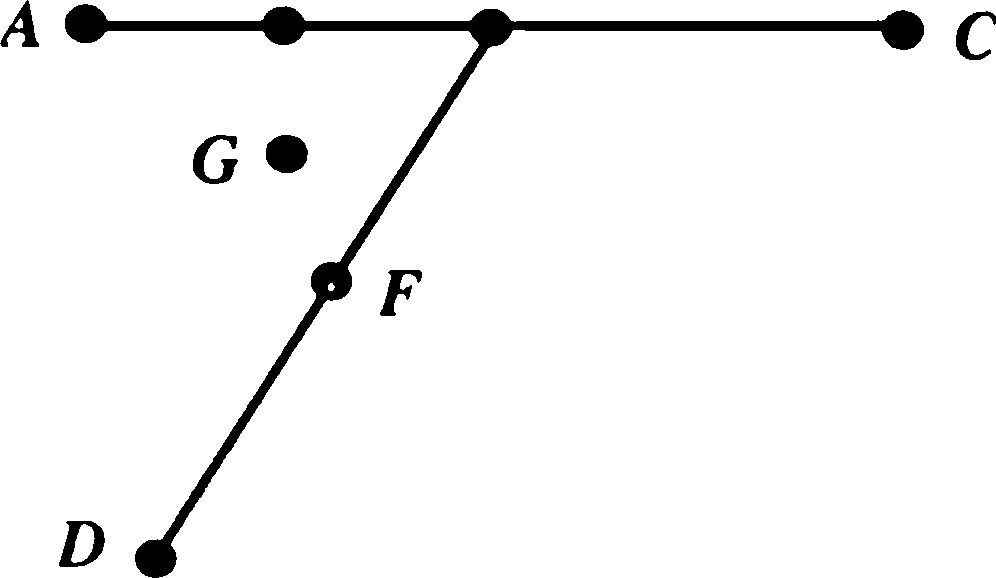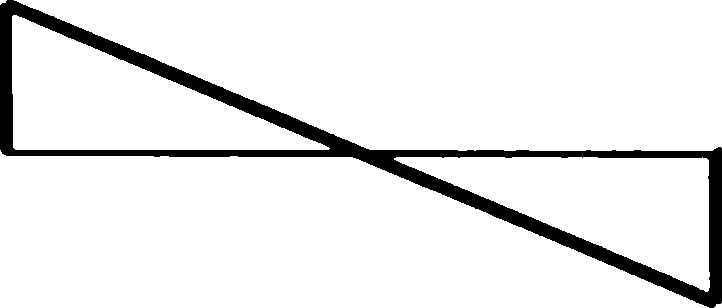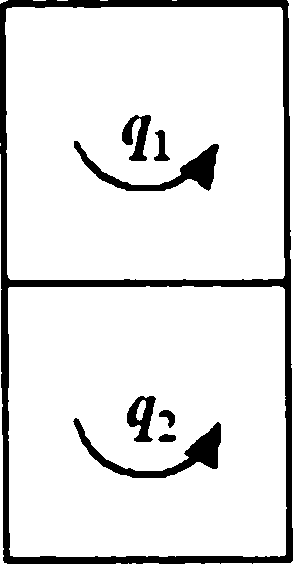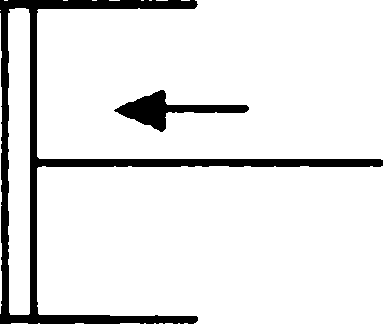Indian Institute of Technology Madras (IIT-M) 2009 B.Tech Aeronautical Engineering Aerospace engineering gate- - Question Paper
2009 AE
AE : AEROSPACE ENGINEERING
Duration : Three Hours Maximum Marks :100
Read the following instructions carefully.
1. This question paper contains 16 printed pages including pages for rough work. Please check all pages and report discrepancy, if any.
2. Write your registration number, your name and name of the examination centre at the specified locations on the right half of the Optical Response Sheet (ORS).
3. Using HB pencil, darken the appropriate bubble under each digit of your registration number and the letters corresponding to your paper code.
4. All questions in this paper are of objective type.
5. Questions must be answered on Optical Response Sheet (ORS) by darkening the appropriate bubble (marked A, B, C, D) using HB pencil against the question number on the left hand side of the ORS. Each question has only one correct answer. In case you wish to change an answer, erase the old answer completely. More than one answer bubbled against a question will be treated as an incorrect response.
6. There are a total of 60 questions carrying 100 marks. Questions 1 through 20 are 1-mark questions, questions 21 through 60 are 2-mark questions.
7. Questions 51 through 56 (3 pairs) are common data questions and question pairs (57, 58) and (59, 60) are linked answer questions. The answer to the second question of the above 2 pairs depends on the answer to the first question of the pair. If the first question in the linked pair is wrongly answered or is un-attempted, then the answer to the second question in the pair will not be evaluated.
8. Un-attempted questions will carry zero marks.
9. Wrong answers will carry NEGATIVE marks. For Q.l to Q.20, A mark will be deducted for each wrong answer. For Q. 21 to Q.56, 2A mark will be deducted for each wrong answer. The question pairs (Q.57, Q.58), and (Q.59, Q.60) are questions with linked answers. There will be negative marks only for wrong answer to the first question of the linked answer question pair i.e. for Q.57 and Q.59, 3A mark will be deducted for each wrong answer. There is no negative marking for Q.58 and Q.60.
10. Calculator (without data connectivity) is allowed in the examination hall.
11. Charts, graph sheets or tables are NOT allowed in the examination hall.
12. Rough work can be done on the question paper itself. Additionally, blank pages are given at the end of the question paper for rough work.
Q. 1 - Q. 20 carry one mark each.
Q.l For a flow through a Prandtl-Meyer expansion wave
(A) Mach number stays constant. (B) Entropy stays constant.
(C) Temperature stays constant. (D) Density stays constant.
Q.2 For two-dimensional irrotational and incompressible flows
(A) Both potential and stream functions satisfy the Laplace equation.
(B) Potential function must satisfy the Laplace equation but the stream function need not.
(C) Stream function must satisfy the Laplace equation but the potential function need not.
(D) Neither the stream function nor the potential function need to satisfy the Laplace equation.
Q.3 A trailing edge plain flap deflected downward increases the lift coefficient of an airfoil by
(A) Increasing the effective camber of the airfoil.
(B) Delaying the separation of the flow from the airfoil surface.
(C) Increasing the local airspeed near the trailing edge.
(D) Controlling the growth of the boundary layer thickness along the airfoil surface.
Q.4 Thin airfoil theory predicts that the lift slope is - = 2n for
(A) Symmetric airfoils only. (B) Cambered airfoils only.
(C) Any airfoil shape. (D) Joukowski airfoils only.
Q.5 The ordinary differential equation = 0 where k is real and positive
(A) is non-linear
(B) has a characteristic equation with one real and one complex root
(C) has a characteristic equation with two real roots
(D) has a complementary function that is simple harmonic
Q.6 A non-trivial solution to the (nxn) system of equations []{*}=={0} where {0} is the null vector
(A) can never be found
(B) may be found only if [A] is not singular
(C) may be found only if [A] is an orthogonal matrix
(D) may be found only if [A] has at least one eigenvalue equal to zero
Q.7 For a plane strain problem, the stresses satisfy the condition
(A) rxz = Tyz=az=0 Wrxz=ryz=0,az=v(<rx + aJ,)
(D) txz = ryz 0,(7z =v(ax +o->,) + (l-v)rl>
Q.8 The propulsive efficiency of a turbo-jet engine moving at velocity and having exhaust velocity Ug with respect to the engine is given by
(A)-I:: <B)l-=- (C) (D) 2U~
Q.9 An aircraft is flying at M = 2 where the ambient temperature around the aircraft is 250 K. If the specific heat ratio for air y 1.4, the stagnation temperature on the surface of the aircraft is
(A) 200 K (B) 450 K (C) 350 K (D) 1450 K
Q.10 The division of feed air to an aircraft gas-turbine combustor into primary and secondary streams serves which of the following purposes ?
P. a flammable mixture can be formed
Q. cooling of combustor liner and flame tube can be accomplished R. specific fuel consumption can be reduced
(A) P and R (B) Q and R (C) P and Q (D) P, Q and R
Q.ll Classify the following propellants as: cryogenic (C), semi-cryogenic (SC), compressed gas (CG) and earth storable (ES)
N2O4-UDMH (nitrogen tetra oxide and unsymmetrical di-methyl hydrazine)
LOX-RP1 (liquid oxygen and kerosene)
LOX-LH2 (liquid oxygen and liquid hydrogen)
N2 (nitrogen gas)
(A) N204-UDMH (ES), LOX-RP1 (C), LOX-LH2 (C), N2 (C)
(B) N204-UDMH (SC), LOX-RP1 (SC), LOX-LH2 (C), N2 (C)
(C) N204-UDMH (ES), LOX-RP1 (SC), LOX-LH2 (C), N2 (CG)
(D) N204-UDMH (ES), LOX-RP1 (C), LOX-LH2 (C), N2 (CG)
Q. 12 A conventional altimeter is a
(A) Pressure transducer (B) Temperature transducer
(C) Density transducer (D) Velocity transducer
Q.13 The relation between an airplanes true airspeed Vand equivalent airspeed Vin terms of the
p
density ratio (cr = ), where p0 is the air density at sea-level and p is the air density at the altitude Po
at which the airplane is flying, is given by the formula:
(A )Yeas_ = ij (B)=Cr2
Vtas Vtas
TAS tas 'f&
Q.14 An unswept fixed-winged aircraft has a large roll stability if the wing is placed
(A) low on the fuselage and has negative dihedral angle
(B) low on the fuselage and has positive dihedral angle
(C) high on the fuselage and has negative dihedral angle
(D) high on the fuselage and has positive dihedral angle
Q. 15 Thrust available from a turbojet engine
(A) increases as altitude increases
(B) increases up to the tropopause and then decreases
(C) remains constant at all altitudes
(D) decreases as altitude increases
Q.16 If Cmcc is the pitching moment coefficient about the center of gravity of an aircraft, and Ct is the angle
of attack, then is da
(A) a stability derivative which represents stiffness in pitch
(B) a stability derivative which represents damping in pitch
(C) a control derivative in pitch
(D) positive for an aircraft that is stable in pitch
Q.17 The life of a geo-stationary communications satellite is limited by
(A) the working life of the on-board electronic circuitry
(B) the time it takes for its orbit to decay due to atmospheric drag
(C) the quantity of on-board fuel available for station-keeping
(D) the number of meteorite impacts that the satellite structure can withstand before breaking up
Q.18 For a critically damped single degree of freedom spring - mass - damper system with a damping constant c of 4 Ns/m and spring constant k of 16 N/m, the system mass m is
(A) 0.5 kg (C) 2 kg
(B) 0.25 kg (D) 4 kg
Q.19 In a thin walled rectangular tube subjected to equal and opposite forces P as shown in the figure, the shear stress along leg AB is

B
A
P\T
(A) zero
(C) varies linearly
(B) constant non-zero (D) varies parabolically
|
Q.20 For the thin walled beam cross section as shown in the figure, the shear centre lies at E B |
 |
|
(A) Mid point of AB, i.e. at point E (C) Junction point B |
(B) Mid point of BD, i.e. at point F (D) at a point G lying within the area ABC |
Q. 21 to Q. 60 carry two marks each.
specific impulse of the propulsion system (in seconds) and g is the acceleration due to gravity, then the maximum velocity that can be attained by the rocket vehicle in the absence of gravity and atmospheric drag is given by
M,
(A) glsp In
(B) glsp In
-1
M;
Ml + Ms
A#<
Mi
M,
(C) glsp In
(D) glsp In
{M0-MP
Q.22 An ideal axial compressor is driven by an ideal turbine across which the total temperature ratio is 0.667. If the total temperature at turbine inlet is T0 = 1500 K and specific heat of gas cp = 1 kJ/kg/K , the power drawn by the compressor per unit mass flow rate of air is approximately
(A) 300 kW/kg/s (B) 1000 kW/kg/s (C) 600 kW/kg/s (D) 500 kW/kg/s
Q.23 The performance of a solid rocket motor is improved by replacing the old propellant with a new one. The new propellant gives a combustion temperature 40% higher than the previous propellant without appreciable change in molecular weight of combustion products and other operating parameters. By approximately what percentage is the specific impulse of the new motor higher than the old one ?
(A) 18% (B) 96% (C)42% (D) 112%
Q.24 A solid rocket motor has an end burning grain of cross-sectional areaAcs =0.4 m2. The density of
propellant is pp = 1500 kg / m3 and has linear regression rate r = 5 mm/s. If the specific impulse of the propulsion system is / = 200 seconds, the thrust produced by the motor is approximately
sp
(A) 3 kN (B)6kN (C) 1.5 kN (D) 12 kN
Q.25 An ideal ramjet is flying at an altitude of 10 km with a velocity of 1 km/s. The ambient pressure is 0.25 bar and temperature is 225 K. The exhaust gases from the engine are optimally expanded and leave the nozzle at 900 K. If the specific heat ratio (y) remains constant, the specific thrust developed by the engine is approximately
(A) 1000 N-s/kg (B) 2000 N-s/kg (C) 500 N-s/kg (D) 4000 N-s/kg
Q.26 A combat aircraft engine is equipped with an afterburner followed by a variable area convergent nozzle (operating with the nozzle choked). The exhaust gas temperature is 750 K when afterburner is off and 3000 K when it is on. When the afterburner is turned on, (assuming the total pressure remains the same, the mass of fuel added in the afterburner is negligible i.e., the mass flow rate remains the same, and the specific heat ratio (y) remains constant), approximately by what factor must the nozzle area be changed ?
(A) 0.5 (B) 4 (C) 1 (D) 2
Q.27 An airplane flying at 100 m/s is pitching at the rate of 0.2 deg/s. Due to this pitching, the horizontal tail surface located 4 metres behind the centre-of-mass of the airplane will experience a change in angle of attack, which is
(A) 0.01 deg (B) 0.008 deg (C)0.04deg (D) 0.004 deg
Q.28 The contribution of the horizontal tail to the pitching moment coefficient about the center of gravity (COT ) of an aircraft is given by =0.2 0.0215 a, where a is the angle of attack of the
aircraft. The contribution of the tail to the aircraft longitudinal stability
(A) is stabilizing
(B) is destabilizing
(C) is nil
(D) cannot be determined from the given information
Q.29 The linearized dynamics of an aircraft (which has no large rotating components) in straight and level flight is governed by the equations
M [Bite] [D]
dx
~dt
where x = [w w q 0 v p r 0]7,[]r represents the transpose of a matrix, [A], [], [C]
and [D] are 4x4 matrices and [0] is the 4x4 null matrix. Which of the following is true ?
(A)[A]/[0]; [SMO]; [C] = [0]; [D]*[0]
(B) [A] = [0]; [BMO]; [c]*[0]; [D] = [0]
(C) [A] * [0]; [B] = [0]; [C] = [0]; [D] * [0]
(D)[AM0]; [fi] = [0]; [CM0]; [D] = [0]
Q.30 The velocity vector of an aircraft along its body-fixed axis is given by V =
of V , CC is the angle of attack and is the angle of sideslip, which of the following set of relations is correct ?
If V is the magnitude
(A) u = Vsincoscr, v = Vsin/3; w = Vcos/3sina
(B) u = V cos p cos a; v = V cos w = V cos sin a
(C) u = Vcos/3cos a; v = Vsin w = V sin (3 sin a
(D) u = V cos P cos a; v = V sin /3; w = V cos /3 sin a
Q.31 An aircraft of mass 2500 kg in straight and level flight at a constant speed of 100 m/s has available excess power of 1.0 x 106 W. The steady rate of climb it can attain at that speed is
(A) 100 m/s (B) 60 m/s (C) 40 m/s (D) 20 m/s
Q.32 The acceleration due to gravity on the surface of Mars is 0.385 times that on earth, and the diameter of Mars is 0.532 times that of earth. The ratio of the escape velocity from the surface of Mars to the escape velocity from the surface of earth is approximately
(A) 0.453 (B) 0.205 (C) 0.851 (D) 0.724
Q.33 Which of the following statements are true for flow across a stationary normal shock ?
P. Stagnation temperature stays constant.
Q. Stagnation pressure decreases.
R. Entropy increases.
S. Stagnation pressure increases.
T. Stagnation temperature increases.
(A) P, Q, R (B) Q, R, S (C) R, S, T (D) S, T, P
Q.34 A model airfoil in a wind tunnel that is operating at 50 m/s develops a minimum pressure co-efficient of - 6.29 at some point on its upper surface. The local airspeed at that point is
(A) 50 m/s (B) 125 m/s (C) 135 m/s (D) 150 m/s
Q.35 A symmetrical airfoil section produces a lift coefficient of 0.53 at an angle of attack of 5 degrees measured from its chord line. An untwisted wing of elliptical planform and aspect ratio 6 is made of this airfoil. At an angle of attack of 5 degrees relative to its chordal plane, this wing would produce a lift coefficient of
(A) 0.53 (B) 0.48 (C) 0.40 (D) 0.36
Consider an ideal flow of density p through a variable area duct as shown in the figure below :
CD
Q.36
(2)
Let the cross-sectional areas at sections (1) and (2) be A, and \ respectively. The velocity measured at section (1) using a Pitot static probe is V,. Then the static pressure drop p2 px is
A2
(A )~p
42''
(D) --p
(O-P
Two vortices of the same strength and sign are placed a distance d apart as shown below. Assume that the vortices are free to move and the fluid is ideal.
Q.37
Which of the following statements is true ?
to finally merge and form one
(A) Vortices 1 and 2 spiral inwards with an initial angular speed-z-
2nd
vortex of twice the strength.
(B) Vortices 1 and 2 spiral inwards with an initial angular speed- to finally merge and form one
ltd
vortex of twice the strength.
d
(C) Vortices 1 and 2 perpetually revolve about the midpoint P with radius of revolution and angular
speed .
2nd1
d
(D) Vortices 1 and 2 perpetually revolve about the midpoint P with radius of revolution and angular
speed . nd
The laminar boundary layer over a large flat plate held parallel to the flow is 7.2 mm thick at a point 0.33 m downstream of the leading edge. If the free stream speed is increased by 50%, then the new boundary layer thickness at this location will be approximately
Q.38
(D) 4.8 mm
(C) 5.9 mm
(B) 8.8 mm
(A) 10.8 mm
AE
Q.39 Consider a simply supported beam of length 2L with an overhang of length L, loaded by an end moment M, as shown below.
|
The bending moment distribution for this beam is (A) |
 |
(B)
(C)
(D)

Q.40 For the spring-mass system shown below, the natural frequencies are
k
AA/W
7/11
7~7
w2
~7r
(B) 0 and lk + ]j 2mim2
\k(mx + m2) mxiiV2
(A) 0 and
(C) 0 and
(D) 0 and
Q.41 The buckling load for a simply supported column of rectangular cross section of dimensions
1 cm x 1.5 cm and length 0.5 m made of steel ( = 210x109 N/m2) is approximately
(B) 4 kN
(C) 23 kN
(D) 46 kN
(A) 10 kN
A wing root cross section is idealized using lumped areas (booms) as shown below.
Q.42
l ciir
-r O
1 ciir O
chord line
0.025 m
-y
0.025 in
a-
1 cm*
1 fin* <
0.5 in
The wing root bending moment in steady level flight is My = 10 N-m. If the airplane flies at a load factor n 3.5, the maximum bending stress at the root is
(A) 1x10 N/m
(D) 0.286 xlO6 N/m:
A uniform rigid bar of mass m = 1 kg and length L = 1 m is pivoted at A. It is supported by a stiffness k = 1 N/m and a viscous damper of damping constant C = 1 N-s/m, with a = I
shown below. The moment of inertia of the rigid bar is IA =
N-
The system is
(A) overdamped
(B) underdamped with natural frequency 0)n= 1 rad/s
(C) critically damped
(D) underdamped with natural frequency (On = 2 rad/s
A 2-celled tube with wall thickness 0.5 mm is subjected to a torque of 10 N-m. The resulting shear flows in the two cells are qt and q2 as shown below.
Q.44
|
50 mm | |
 |
50 mm 50 mm |
The torque balance equation (Bredt-Batho formula) for this section leads to
(A) q] - q2 = 2000 N/m (B) qx + 2q2 - 2000 N/m
(C) qx+q2 = 2000 N/m (D) 2q{ +q2 = 2000 N/m
dx
evaluated using the trapezoidal rule with two equal intervals is
l + A: + sin x
(C) 1.41
(D) 0.71
Q.45 The value of the integral J
0
approximately
(A) 1.27 (B) 1.81
| |||||||||||||||
|
(A) 20 (B) 24 (C) 9 |
Q.47 In the interval 1 < x < 2, the function f(x) = enx + sin nx is
(D) 17
(B) maximum at x = 2
(A) maximum at x = 1 (C) maximum at x = 1.5
(D) monotonically decreasing
Q.48 The inverse Laplace transform of F(s) =-+ is
(A) 2**+!*-*
7 7
(C) -e' + -e3' 7 7
3 At 4 31 (B) -e-4'+-e3'
(D)le4, + 6e-3,
7 7
1 2 2 4
and b = I > has 3
Q.49 The linear system of equations Ax = b where A =
(B) infinitely many solutions
(A) no solution
(C) a unique solution x =
0.5
(D) a unique solution x =
Q.50 The correct iterative scheme for finding the square root of a positive real number R using the Newton Raphson method is
R
(B) -Vl
xn +
() Xn+\=\{'fR+xn)
(A) xn+l = -J~R
<C) tn+l=(%/ + VT)
Common Data Questions Common Data for Questions 51 and 52:
The roots of the characteristic equation for the longitudinal dynamics of a certain aircraft are: \ = -0.02 + 0.2/; A2 = -0.02 - 0.2/; A3 = -2.5 + 2.6/; A4 = -2.5 - 2.6i, where i = V-T.
Q.51 The pair of eigenvalues that represent the phugoid mode is
(A) Aj and A3 (B) A2 and A4 (C) A3 and A4 (D) \ and A2
Q.52 The short period damped frequency is
(A) 2.6 rad/s (B) 0.2 rad/s (C) 2.5 rad/s (D) 0.02 rad/s
Common Data for Questions 53 and 54:
Consider the vector field A ={y +z )i+(jc +z )j + (x +y )k defined over the unit sphere x2 + y2 + z2 = 1.
Q.53 The surface integral (taken over the unit sphere) of the component of A normal to the surface is (A) n (B) 1 (C) 0 (D) An
Q.54 The magnitude of the component of A normal to the spherical surface at the point
J_ J_ JL S'S'S
IS
(A) - (B) - (C) - (D) -
3 3 3 3
Common Data for Questions 55 and 56:
The partial differential equation for the torsional vibration of a shaft of length L, torsional rigidity GJ, and mass
polar moment of inertia per unit length I, is I = GJ =-, where 6 is the twist.
dt1 dx2
30
(A)ar
= 0
jc=0
Q.55 If the shaft is fixed at both ends, the boundary conditions are:
(B) 0(0) = 0 and 0(L) = O
n d6 = 0 and
dx
x-L
d0
(C)a7
do
dx
= 0 and 6(L) = 0
(D) 0(0) = 0 and
= 0
x=0
x=L
.th
Q.56 If the n mode shape of torsional vibration of the above shaft is sin frequency of vibration, i.e., COn, is given by
then the nth natural
(2 n + \)n GJ 2 L V /
(B) (On (D) con
(2n + l)n GJ L V /
nn GJ
(A)<y"=TVT
nn GJ
()<0"~2L\T
Linked Answer Questions
Statement for Linked Answer Questions 57 and 58:
Air enters the combustor of a gas-turbine engine at a total temperature T0 of 500 K. The air stream is split into two parts: primary and secondary streams. The primary stream reacts with fuel supplied at a fuel-air ratio of 0.05. The resulting combustion products are then mixed with the secondary air stream to obtain gas with total temperature of 1550 K at the turbine inlet. The fuel has a heating value of 42 MJ/kg. The specific heats of air and combustion products are taken as cp = 1 kJ/kg/K .
Q.57 If the sensible enthalpy of fuel is neglected, the temperature of combustion products from the reaction of primary air stream with fuel is approximately
(A) 2100 K (B) 3200 K (C) 2600 K (D)1800K
Q.58 The approximate ratio of mass flow rates of the primary air stream to the secondary air stream required to achieve the turbine inlet total temperature of 1550 K is
(A) 2:1 (B) 1:2 (C) 1:1.5 (D) 1:1
Statement for Linked Answer Questions 59 and 60:
A piston compresses 1 kg of air inside a cylinder as shown

The rate at which the piston does work on the air is 3000 W. At the same time, heat is being lost through the walls of the cylinder at a rate of 847.5 W.
Q.59 After 10 seconds, the change in specific internal energy of the air is
(A) 21,525 J/kg (B) - 21,525 J/kg (C) 30,000 J/kg (D) - 8,475 J/kg
Q.60 Given that the specific heats of air at constant pressure and volume are cp =1004.5 J/kg-Kand cv =717.5 J/kg-K respectively, the corresponding change in the temperature of the air is
(A) 21.4 K (B) -21.4 K (C) 30 K (D) -30 K
END OF THE QUESTION PAPER
AE 13/16
|
Attachment: |
| Earning: Approval pending. |
